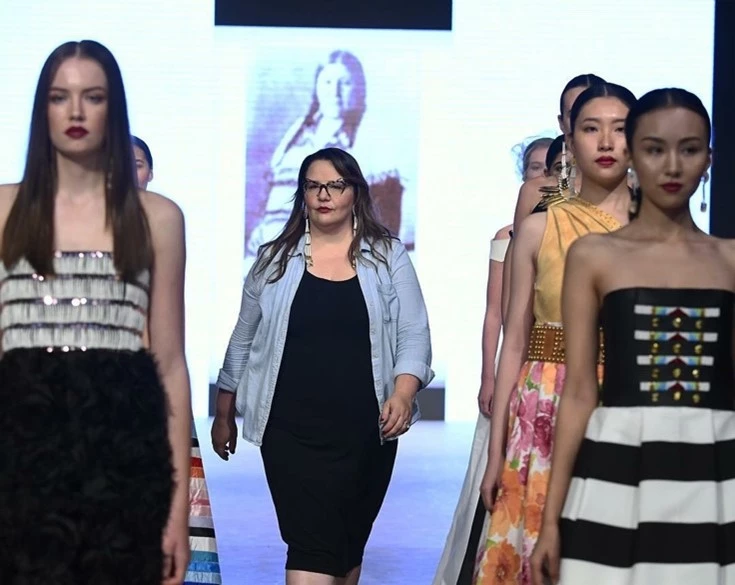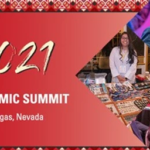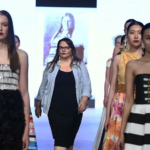Red Berry Woman opened with a passion for sewing, beading, contemporary fashion, and a request to sew dresses for the former Miss Indian World. Needless to say, owner and operator Norma Flying Horse has had an unanticipated rise to the top of the American Indigenous fashion world. Norma has dressed “an array of Indigenous people from various walks of life from title holders, politicians, activists, actors, and the business world.” Norma Flying Horse has brough contemporary Indigenous fashion to the larger fashion world, attending international fashion shows including Paris Fashion Week, and hosting Red Berry Woman’s own fashion show annually.
We hope you enjoy reading about Red Berry Woman, Norma Flying Horse, and the world of Indigenous fashion!
1. Tell us a little bit about yourself.
My name is Norma Flying Horse, I am the Owner/Operator of Red Berry and an enrolled member of the Hidatsa people of the Mandan, Hidatsa, and Arikara Nation. I’m also a member of the Dakota Sioux and Assiniboine Tribes. I currently reside on the Fort Berthold Indian Reservation of North Dakota with my husband and children. I currently work as a government staffer for my tribal government, but I am best known for my work as Red Berry Woman, contemporary Indigenous fashion.
2. Tell us a about how you got the idea to open Red Berry Woman. Where did the name come from?
Red Berry Woman is my name given to me by my Dakota Sioux people. I felt using my name was appropriate as our names are attached to our spirits and to all we do. My business began unintentionally when I was asked to sew dresses for the former Miss Indian World, Cheyenne Brady, for her public events. Once she started wearing my designs, I began receiving requests from across the U.S. and Canada from people who wanted to wear my work at various events. Since then I have dressed an array of Indigenous people from various walks of life from title holders, politicians, activists, actors, and the business world.
3. What inspired you to start your company and brand?
I have been sewing and beading from a young age, trades I inherited from both my grandmother and my mother and I have been an admirer of contemporary fashion since I was a little girl. So combining the two came naturally. When I started receiving requests to be a part of Native Fashion shows back in 2016 was when I realized I actually had a business. With the support of my family and friends, I have been finding my way through creating a business in the fashion world.
4. How have you been managing the pandemic? What measures are you taking to keep yourself and customers safe?
With my business being online, it has made it easier to remain safe. My work is currently custom so for the majority of the time I only require measurements from a customer. What has been difficult is not being able to take part in fashion shows and fashion events where a lot of my work gets seen live by so many.
5. What are some of the events where your work is showcased?
I’m normally involved in fashion shows throughout the U.S. and Canada, including my own that I have hosted since 2016. With COVID-19 cases only rising this past year, fashions shows have become virtual, including mine, which was to be filmed earlier this month but had to be canceled as North Dakota became the leading state for COVID-19 cases. I wasn’t willing to take the chance.
However, my RBW work can still be viewed as I will have three exhibit pieces for three different museum showcases. One is the RBW dress that walked the red carpet of the Grammy Awards, it will be displayed for the “Fashion of North Dakota” exhibit at the North Dakota Heritage Center in Bismarck, N.D. I will also have two pieces being shown at the new MHA museum on the Fort Berthold Indian Reservation, one will be the RBW dress that was worn on the Oscar stage by activist Alice Brownotter during the Andra Day performance, and the other will be a contemporary ribbon dress and beadwork.
6. Are you planning to expand your brand?
I have only been a couture designer, but I am going to begin a new venture into the ready-to-wear side of fashion. These will be pieces that can be worn by both men and women every day. My motivation to create this line comes from my late daughter, Cameron Sarai, Holy Spirit (her given Native name). My husband and I lost our daughter to a syndrome called Trisomy 18 earlier this year after she lived for twenty-three days. I made a promise to my daughter I would continue my RBW work the best I could, and I want this line to be in her honor and memory.
7. We know you have traveled to major fashion shows abroad. Tell us about your experiences and the people you have met?
I have been blessed to have my work walk the runway of some amazing shows abroad, two of which were Vancouver Fashion Week in Canada and Paris Fashion Week for the Fashion Week Studio. I never dreamed I would be showcasing my work at shows of that caliber. I met several designers, producers, and models who were able to teach me so much about the world of fashion. My work was well received, and I was honored to have been invited as a designer. Because my RBW work was seen on these runways, I was nominated for the International Indigenous Designer of the Year award by International Indigenous Fashion Week, which I received this past October.
8. How has the National Center helped your business?
I have attended RES several times as a staffer for my tribal government. I enjoy seeing so many motivated and successful Indigenous people each year.
9. Any advice for aspiring Native entrepreneurs?
The only advice I can give anyone is: don’t doubt yourself; persistence and hard work can go a long way.
10. Where can customers find you?
I have Social Media outlets on Facebook, Red Berry Woman and Instagram, red_berry_woman. I also have a website www.redberrywoman.com.











